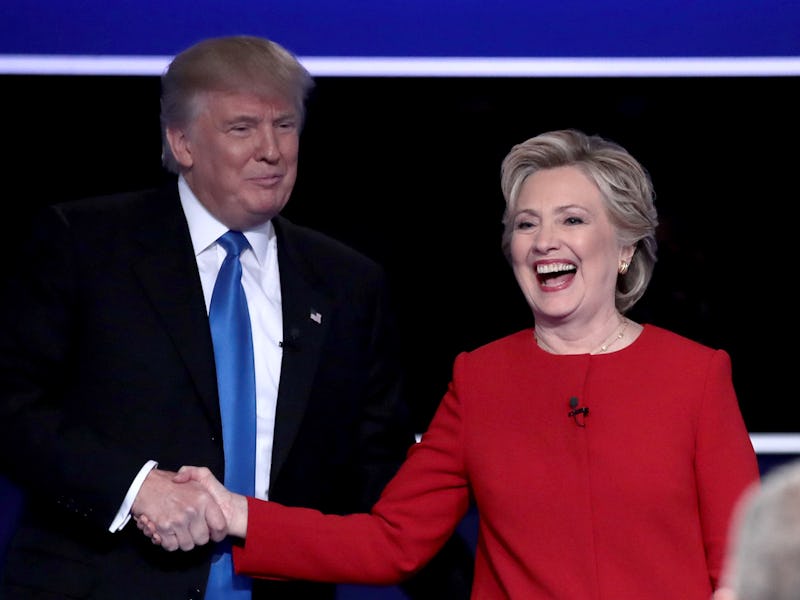Which Election Forecasts Should You Check Before Tuesday?
The blue and red bar is popping up everywhere this year, why?

We’re just a few days from the end of our national election season nightmare. A lot of outlets are offering a high percentage of likelihood that Hillary Clinton will win the presidential race, while Donald Trump continues to insist the polls are leaning in his favor.
A new visual feature that’s been adopted by political and news organizations is a horizontal prediction meter. The red-and-blue bar has popped up seemingly everywhere, a visual representation of our access to immense amounts of data. Those bars sum up all sorts of what the latest polls are showing, and in a single metric, which candidate has the better chance of winning. But! There are discrepancies.
Which one you choose to follow is up to you, which is pretty fun. What’s really interesting is the methodology used for each one. Which one uses Las Vegas, which is more conservative in the summer and more aggressive in the fall? Read on.
On any given day before the election, there’s no actual way to verify if one meter’s 88 percent chance that Clinton will win is more accurate than another’s 92 percent forecast, but the more you know, the more you can rely on those numbers.
Here are four of the most popular models:
FiveThirtyEight's prediction meter as of Saturday morning.
FiveThirtyEight
Named for the 538 votes in the electoral college, Nate Silver’s ESPN-owned website has been crunching the numbers on the 2016 election since June. Silver correctly predicted the outcome of the 2008 presidential election for 49 states, and for 50 states plus Washington, D.C., for the 2012 presidential election. The guy is a statistics wizard.
FiveThirtyEight actually produces three forecasts, each computed with a slightly different methodology. All the models use polling data, and they all take into account how accurate polls have been in past elections. The models are more conservative in the summer, when polls are less accurate, and are more aggressive as Election Day approaches and polls tend to be closer to the actual outcome.
The polls-only forecast is, you guessed it, just polls. It assumes those polls are the best predictors of the outcome, but they’re not, so there’s a fair amount of uncertainty. The polls-plus forecast pairs poll data with an economic index and takes polling differences into account. For example, likely-voter polls tend to overrepresent Republican voters compared to actual Election Day results. The now-cast shows what the result would be if the election were held today, based on poll data. Recent polls have more weight, and give a more extreme forecast.
The New York Times forecast as of Saturday morning. The meter started appearing on the Times homepage this fall.
The New York Times
The Upshot economics and politics blog over at the New York Times has its own statistical model for the election. It uses a combination of poll data, and takes into account how polls have behaved in the past. Both FiveThirtyEight and the New York Times models downplay polls taken immediately after conventions, but theNew York Times model doesn’t make this correction for polls taken immediately following the debates.
The PredictWise meter as of Saturday morning.
PredictWise
PredictWise got its start back in 2010, and ever since, Microsoft Research economist David Rothschild has been using data from polls, prediction markets, and gambling odds data to forecast the outcomes of sporting events, Game of Thrones, and elections. Notably, it dumps Las Vegas odds into its formula.
The national election forecast uses data from Betfair, Hypermind, and PredictIt (all prediction markets), HuffPost Pollster, and the bookie site Oddschecker. They don’t take third party candidates into account, and bookie data isn’t included in the averages for the overall race. The state-by-state model is more detailed and accounts for incumbents, historical trends, and an economic index. PredictWise’s overall forecast averages these national and state-by-state models.
PEC's meter isn't a meter as much as it is a prediction of who will receive electoral votes.
Princeton Election Consortium
The Princeton Election Consortium, around since 2004, pulls in polling data from HuffPost Pollster for a day-to-day snapshot of the presidential race. Their snapshot model is similar to FiveThirtyEight’s now-cast and looks at what the outcome would be if today were Election Day. The consortium’s predictive model exclusively uses polls and weights them all evenly.
While all the models use some polling data, the diversity of sources and statistical methods means no two models are the same. As election day approaches, some of these models should get more accurate as polls increase in accuracy. But no matter what the forecasts say, the only important outcome is the one on Tuesday, when all the votes are tallied and we know for sure who our next president will be.
As this illustration of the competing forecasts shows, they all follow the same trend line, with slight variations. Which one you choose to follow is up to you.